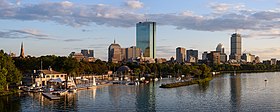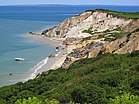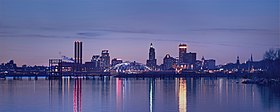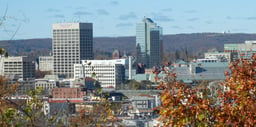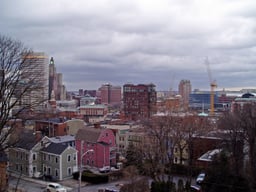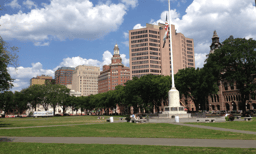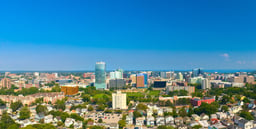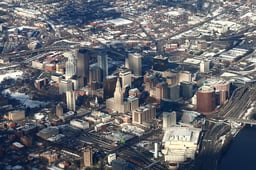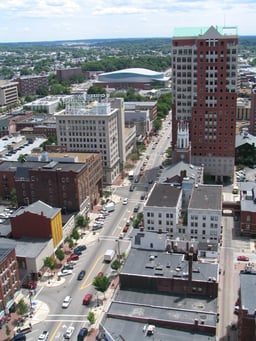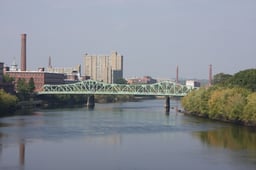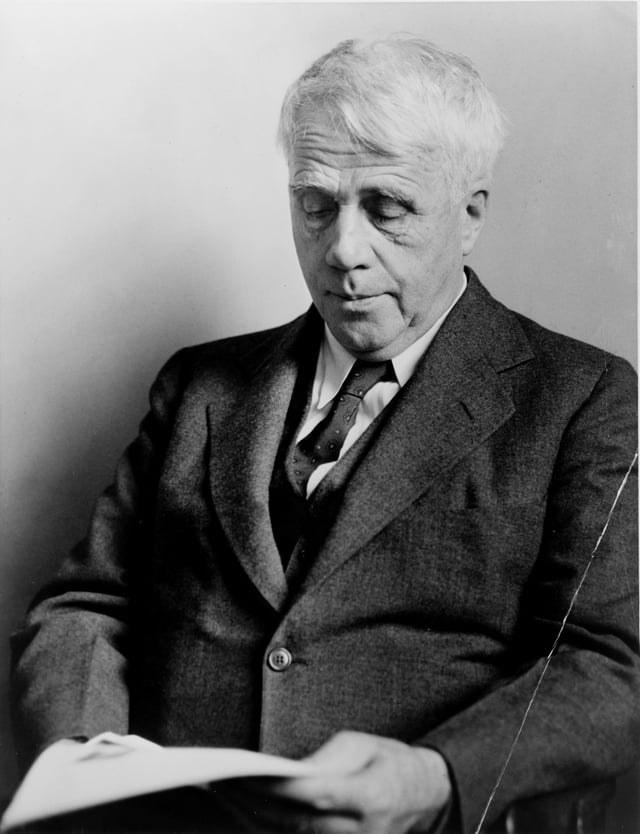New England
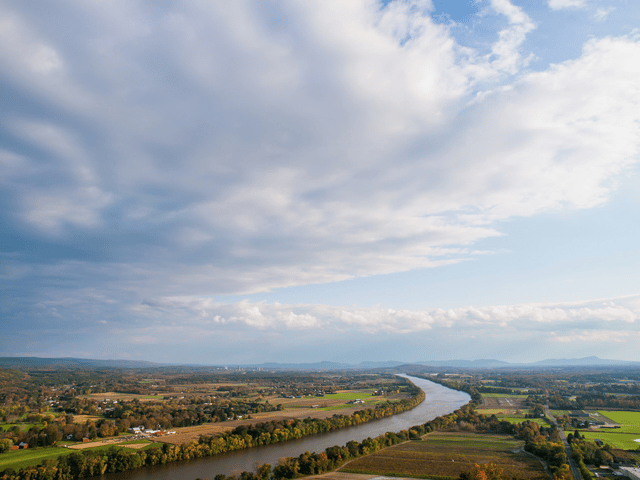
New England

New England | |
|---|---|
Left-right from top: Boston skyline, the Connecticut River valley, the Presidential Range, Burlington skyline, Aquinnah, Portland Head Light in Cape Elizabeth, skyline of Providence | |
| Motto(s): None official. "An appeal to Heaven" and "Nunquam libertas gratior extat" (Latin: "Never does liberty appear in a more gracious form") are common de facto mottos. | |
 Location within the United States | |
| Composition | |
| Largest metropolitan area |
|
| Largest city | Boston |
| Area | |
| • Total | 71,991.8 sq mi (186,458 km2) |
| • Land | 62,688.4 sq mi (162,362 km2) |
| Population (2017 est.)[1] | |
| • Total | 14,810,001 |
| • Density | 210/sq mi (79/km2) |
| Demonym(s) | New Englander, Yankee[2] |
| GDP (nominal) | |
| • Total | $1.1 trillion (2018) |
| • per capita | $74,000 (2018) |
| Dialects | New England English, New England French |
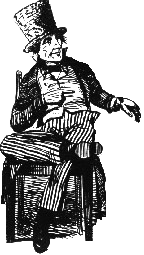
Brother Jonathan, the historical national personification of New England
New England is a region composed of six states in the northeastern United States: Maine, Vermont, New Hampshire, Massachusetts, Rhode Island, and Connecticut.[4][5][6][7][8][9] It is bordered by the state of New York to the west and by the Canadian provinces of New Brunswick to the northeast and Quebec to the north. The Atlantic Ocean is to the east and southeast, and Long Island Sound is to the south. Boston is New England's largest city, as well as the capital of Massachusetts. Greater Boston is the largest metropolitan area, with nearly a third of New England's population; this area includes Worcester, Massachusetts (the second-largest city in New England), Manchester, New Hampshire (the largest city in New Hampshire), and Providence, Rhode Island (the capital and largest city of Rhode Island).
In 1620, Puritan Separatist Pilgrims from England established Plymouth Colony, the second successful English settlement in America, following the Jamestown Settlement in Virginia founded in 1607. Ten years later, more Puritans established Massachusetts Bay Colony north of Plymouth Colony. Over the next 126 years, people in the region fought in four French and Indian Wars, until the English colonists and their Iroquois allies defeated the French and their Algonquian allies in America. In 1692, the town of Salem, Massachusetts and surrounding areas experienced the Salem witch trials, one of the most infamous cases of mass hysteria in history.[10]
In the late 18th century, political leaders from the New England colonies initiated resistance to Britain's taxes without the consent of the colonists. Residents of Rhode Island captured and burned a British ship which was enforcing unpopular trade restrictions, and residents of Boston threw British tea into the harbor. Britain responded with a series of punitive laws stripping Massachusetts of self-government which the colonists called the "Intolerable Acts". These confrontations led to the first battles of the American Revolutionary War in 1775 and the expulsion of the British authorities from the region in spring 1776. The region played a prominent role in the movement to abolish slavery in the United States, and was the first region of the U.S. transformed by the Industrial Revolution, centered on the Blackstone and Merrimack river valleys.
The physical geography of New England is diverse for such a small area. Southeastern New England is covered by a narrow coastal plain, while the western and northern regions are dominated by the rolling hills and worn-down peaks of the northern end of the Appalachian Mountains. The Atlantic fall line lies close to the coast, which enabled numerous cities to take advantage of water power along the many rivers, such as the Connecticut River, which bisects the region from north to south.
Each state is subdivided into small incorporated municipalities known as towns, many of which are governed by town meetings. The only unincorporated areas exist in the sparsely populated northern regions of Maine, New Hampshire, and Vermont. New England is one of the Census Bureau's nine regional divisions and the only multi-state region with clear, consistent boundaries. It maintains a strong sense of cultural identity,[11] although the terms of this identity are often contrasted, combining Puritanism with liberalism, agrarian life with industry, and isolation with immigration.
New England | |
|---|---|
Left-right from top: Boston skyline, the Connecticut River valley, the Presidential Range, Burlington skyline, Aquinnah, Portland Head Light in Cape Elizabeth, skyline of Providence | |
| Motto(s): None official. "An appeal to Heaven" and "Nunquam libertas gratior extat" (Latin: "Never does liberty appear in a more gracious form") are common de facto mottos. | |
 Location within the United States | |
| Composition | |
| Largest metropolitan area |
|
| Largest city | Boston |
| Area | |
| • Total | 71,991.8 sq mi (186,458 km2) |
| • Land | 62,688.4 sq mi (162,362 km2) |
| Population (2017 est.)[1] | |
| • Total | 14,810,001 |
| • Density | 210/sq mi (79/km2) |
| Demonym(s) | New Englander, Yankee[2] |
| GDP (nominal) | |
| • Total | $1.1 trillion (2018) |
| • per capita | $74,000 (2018) |
| Dialects | New England English, New England French |
History
The earliest known inhabitants of New England were American Indians who spoke a variety of the Eastern Algonquian languages.[12] Prominent tribes included the Abenakis, Mi'kmaq, Penobscot, Pequots, Mohegans, Narragansetts, Pocumtucks, and Wampanoag.[12] Prior to the arrival of European settlers, the Western Abenakis inhabited New Hampshire, New York, and Vermont, as well as parts of Quebec and western Maine.[13] Their principal town was Norridgewock in Maine.[14]
The Penobscot lived along the Penobscot River in Maine. The Narragansetts and smaller tribes under their sovereignty lived in Rhode Island, west of Narragansett Bay, including Block Island. The Wampanoag occupied southeastern Massachusetts, Rhode Island, and the islands of Martha's Vineyard and Nantucket. The Pocumtucks lived in Western Massachusetts, and the Mohegan and Pequot tribes lived in the Connecticut region. The Connecticut River Valley linked numerous tribes culturally, linguistically, and politically.[12]
Colonial period
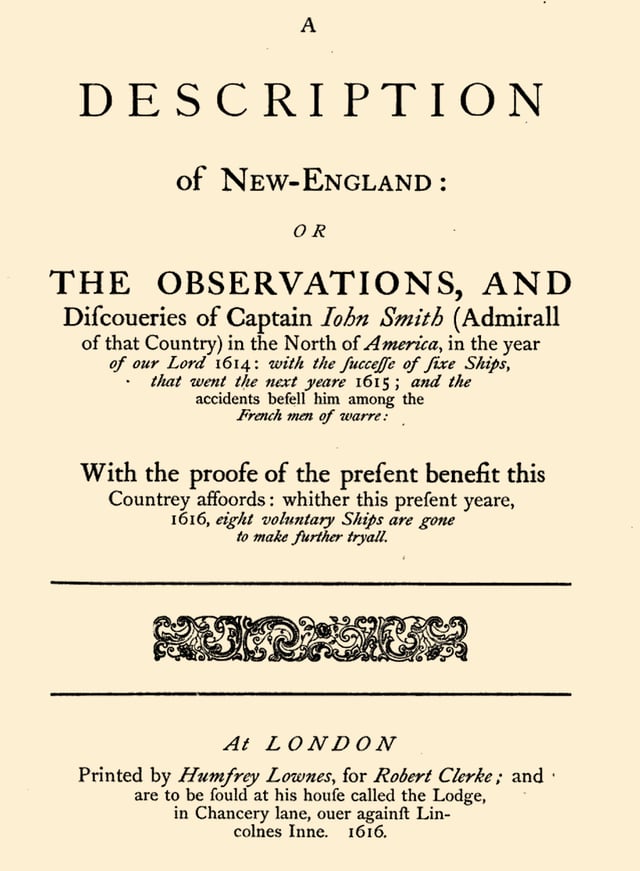
Title page of John Smith's A Description of New England (1616; 1865 reprint)
On April 10, 1606, King James I of England issued a charter for the Virginia Company, which comprised the London Company and the Plymouth Company. These two privately funded ventures were intended to claim land for England, to conduct trade, and to return a profit. In 1620, the Pilgrims arrived on the Mayflower and established Plymouth Colony in Massachusetts, beginning the history of permanent European settlement in New England.[16]
In 1616, English explorer John Smith named the region "New England".[17] The name was officially sanctioned on November 3, 1620[18] when the charter of the Virginia Company of Plymouth was replaced by a royal charter for the Plymouth Council for New England, a joint-stock company established to colonize and govern the region.[19] The Pilgrims wrote and signed the Mayflower Compact before leaving the ship,[20] and it became their first governing document.[21] The Massachusetts Bay Colony came to dominate the area and was established by royal charter in 1629[22][23] with its major town and port of Boston established in 1630.[24]
Massachusetts Puritans began to settle in Connecticut as early as 1633.[25] Roger Williams was banished from Massachusetts for heresy, led a group south, and founded Providence Plantation in the area that became the Colony of Rhode Island and Providence Plantations in 1636.[26][27] At this time, Vermont was yet unsettled, and the territories of New Hampshire and Maine were claimed and governed by Massachusetts.[28]
French and Indian Wars
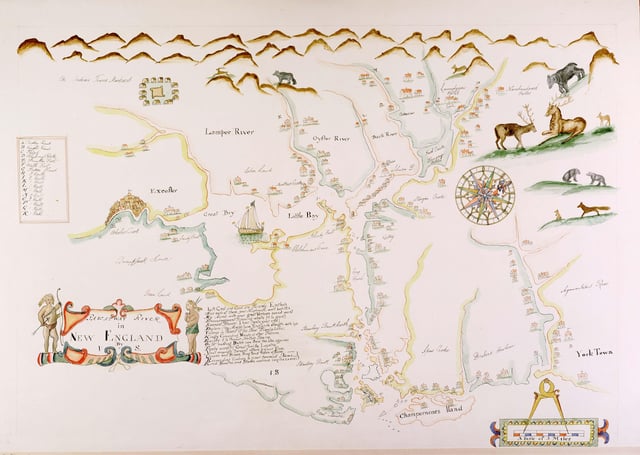
An English map of New England c. 1670 depicts the area around modern Portsmouth, New Hampshire
Relationships between colonists and local Indian tribes alternated between peace and armed skirmishes, the bloodiest of which was the Pequot War in 1637 which resulted in the Mystic massacre.[29] On May 19, 1643, the colonies of Massachusetts Bay, Plymouth, New Haven, and Connecticut joined together in a loose compact called the New England Confederation (officially "The United Colonies of New England"). The confederation was designed largely to coordinate mutual defense, and it gained some importance during King Philip's War[30] which pitted the colonists and their Indian allies against a widespread Indian uprising from June 1675 through April 1678, resulting in killings and massacres on both sides.[31]
During the next 74 years, there were six colonial wars that took place primarily between New England and New France,[32] during which New England was allied with the Iroquois Confederacy and New France was allied with the Wabanaki Confederacy. Mainland Nova Scotia came under the control of New England after the Siege of Port Royal (1710), but both New Brunswick and most of Maine remained contested territory between New England and New France. The British eventually defeated the French in 1763, opening the Connecticut River Valley for British settlement into western New Hampshire and Vermont.
The New England Colonies were settled primarily by farmers who became relatively self-sufficient. Later, New England's economy began to focus on crafts and trade, aided by the Puritan work ethic, in contrast to the Southern colonies which focused on agricultural production while importing finished goods from England.[33]
Dominion of New England

The New England Ensign, one of several flags historically associated with New England. This flag was reportedly used by colonial merchant ships sailing out of New England ports, 1686 – c. 1737.[34][35][36][37][38]
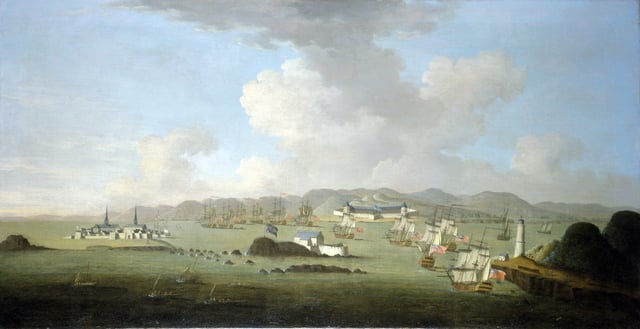
New England's Siege of Louisbourg (1745) by Peter Monamy
By 1686, King James II had become concerned about the increasingly independent ways of the colonies, including their self-governing charters, their open flouting of the Navigation Acts, and their growing military power. He therefore established the Dominion of New England, an administrative union comprising all of the New England colonies.[39] In 1688, the former Dutch colonies of New York, East New Jersey, and West New Jersey were added to the Dominion. The union was imposed from the outside and contrary to the rooted democratic tradition of the region, and it was highly unpopular among the colonists.[40]
The Dominion significantly modified the charters of the colonies, including the appointment of Royal Governors to nearly all of them. There was an uneasy tension between the Royal Governors, their officers, and the elected governing bodies of the colonies. The governors wanted unlimited authority, and the different layers of locally elected officials would often resist them. In most cases, the local town governments continued operating as self-governing bodies, just as they had before the appointment of the governors.[41]
After the Glorious Revolution in 1689, Bostonians overthrew royal governor Sir Edmund Andros. They seized dominion officials and adherents to the Church of England during a popular and bloodless uprising.[42] These tensions eventually culminated in the American Revolution, boiling over with the outbreak of the War of American Independence in 1775. The first battles of the war were fought in Lexington and Concord, Massachusetts, later leading to the Siege of Boston by continental troops. In March 1776, British forces were compelled to retreat from Boston.
New England in the new nation
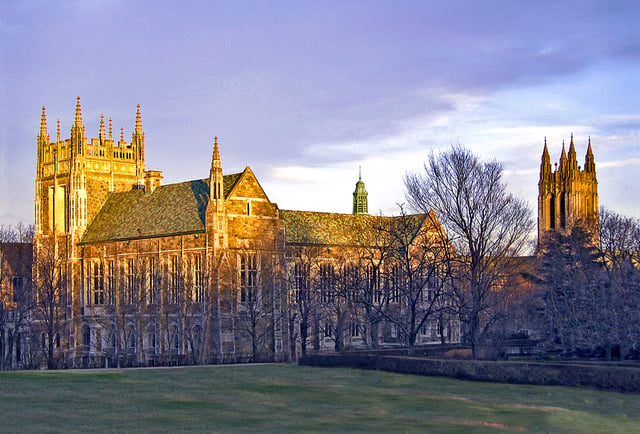
Boston College: the architecture style is Collegiate Gothic, a subgenre of Gothic Revival architecture, a 19th-century movement
After the dissolution of the Dominion of New England, the colonies of New England ceased to function as a unified political unit but remained a defined cultural region. By 1784, all of the states in the region had taken steps towards the abolition of slavery, with Vermont and Massachusetts introducing total abolition in 1777 and 1783, respectively.[43] The nickname "Yankeeland" was sometimes used to denote the New England area, especially among Southerners and the British.[44]
Vermont was admitted to statehood in 1791 after settling a dispute with New York. The territory of Maine had been a part of Massachusetts, but it was granted statehood on March 15, 1820 as part of the Missouri Compromise.[45] Today, New England is defined as the six states of Maine, Vermont, New Hampshire, Massachusetts, Rhode Island, and Connecticut.[5]
New England's economic growth relied heavily on trade with the British Empire,[46] and the region's merchants and politicians strongly opposed trade restrictions. As the United States and the United Kingdom fought the War of 1812, New England Federalists organized the Hartford Convention in the winter of 1814 to discuss the region's grievances concerning the war, and to propose changes to the Constitution to protect the region's interests and maintain its political power.[47] Radical delegates within the convention proposed the region's secession from the United States, but they were outnumbered by moderates who opposed the idea.[48]
Politically, the region often disagreed with the rest of the country.[49] Massachusetts and Connecticut were among the last refuges of the Federalist Party, and New England became the strongest bastion of the new Whig Party when the Second Party System began in the 1830s. The Whigs were usually dominant throughout New England, except in the more Democratic Maine and New Hampshire. Leading statesmen hailed from the region, including Daniel Webster.
Many notable literary and intellectual figures were New Englanders, including Ralph Waldo Emerson, Henry David Thoreau, Nathaniel Hawthorne, Henry Wadsworth Longfellow, John Greenleaf Whittier, George Bancroft, and William H. Prescott.[50]
Industrial Revolution
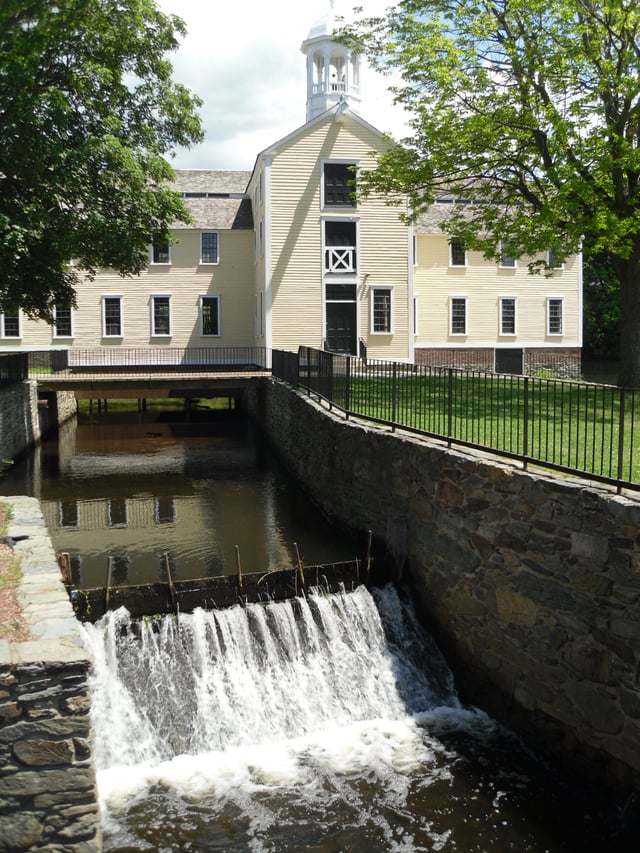
The Slater Mill Historic Site in Pawtucket, Rhode Island

Bread and Roses Strike. Massachusetts National Guard troops surround strikers in Lawrence, Massachusetts, 1912.
New England was key to the industrial revolution in the United States.[51] The Blackstone Valley running through Massachusetts and Rhode Island has been called the birthplace of America's industrial revolution.[52] In 1787, the first cotton mill in America was founded in the North Shore seaport of Beverly, Massachusetts as the Beverly Cotton Manufactory.[53] The Manufactory was also considered the largest cotton mill of its time. Technological developments and achievements from the Manufactory led to the development of more advanced cotton mills, including Slater Mill in Pawtucket, Rhode Island. Towns such as Lawrence, Massachusetts, Lowell, Massachusetts, Woonsocket, Rhode Island, and Lewiston, Maine became centers of the textile industry following the innovations at Slater Mill and the Beverly Cotton Manufactory.
The Connecticut River Valley became a crucible for industrial innovation, particularly the Springfield Armory, pioneering such advances as interchangeable parts and the assembly line which influenced manufacturing processes all around the world.[54] From early in the nineteenth century until the mid-twentieth, the region surrounding Springfield, Massachusetts and Hartford, Connecticut served as the United States' epicenter for advanced manufacturing, drawing skilled workers from all over the world.[55][56]
The rapid growth of textile manufacturing in New England between 1815 and 1860 caused a shortage of workers. Recruiters were hired by mill agents to bring young women and children from the countryside to work in the factories. Between 1830 and 1860, thousands of farm girls moved from rural areas where there was no paid employment to work in the nearby mills, such as the famous Lowell Mill Girls. As the textile industry grew, immigration also grew. By the 1850s, immigrants began working in the mills, especially Irish and French Canadians.[57]
During the same period, New England and areas settled by New Englanders (upstate New York, Ohio's Western Reserve, and the upper midwestern states of Michigan and Wisconsin) were the center of the strongest abolitionist and anti-slavery movements in the United States, coinciding with the Protestant Great Awakening in the region.[59] Abolitionists who demanded immediate emancipation such as William Lloyd Garrison, John Greenleaf Whittier and Wendell Phillips had their base in the region. So too did anti-slavery politicians who wanted to limit the growth of slavery, such as John Quincy Adams, Charles Sumner, and John P. Hale. When the anti-slavery Republican Party was formed in the 1850s, all of New England, including areas that had previously been strongholds for both the Whig and the Democratic Parties, became strongly Republican. New England remained solidly Republican until Catholics began to mobilize behind the Democrats, especially in 1928, and up until the Republican party realigned its politics in a shift known as the Southern strategy. This led to the end of "Yankee Republicanism" and began New England's relatively swift transition into a consistently Democratic stronghold.[60]
20th century and beyond
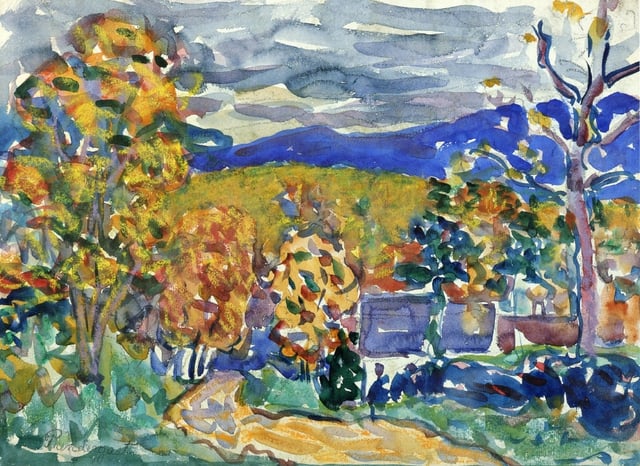
Autumn in New England, watercolor, Maurice Prendergast. C. 1910–1913
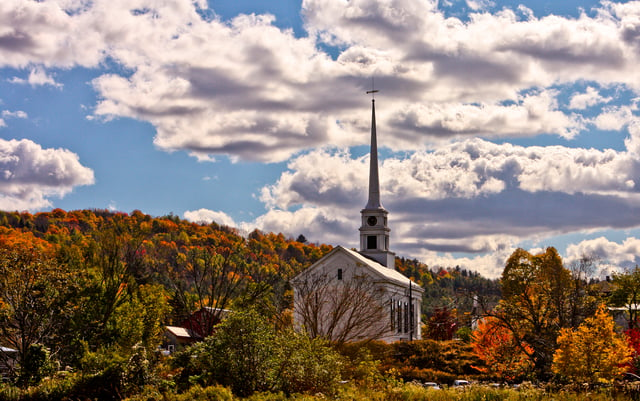
Fall foliage in the town of Stowe, Vermont
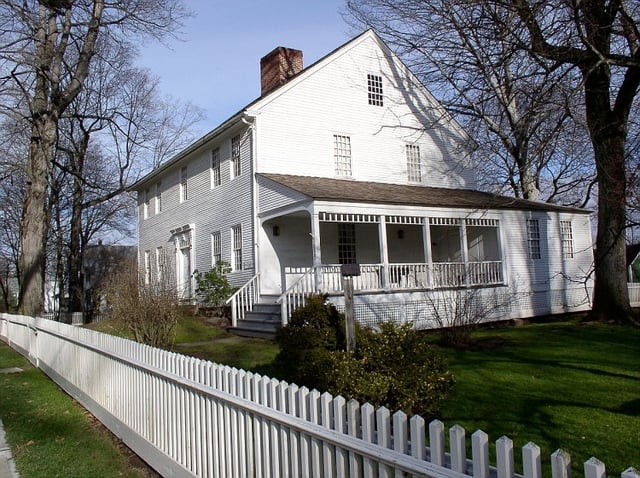
Alexander King House in Suffield, Connecticut
The flow of immigrants continued at a steady pace from the 1840s until cut off by World War I. The largest numbers came from Ireland and Britain before 1890, and after that from Quebec, Italy and Southern Europe. The immigrants filled the ranks of factory workers, craftsmen and unskilled laborers. The Irish assumed a larger and larger role in the Democratic Party in the cities and statewide, while the rural areas remained Republican. Yankees left the farms, which never were highly productive; many headed west, while others became professionals and businessmen in the New England cities.
The Great Depression in the United States of the 1930s hit the region hard, with high unemployment in the industrial cities. The Democrats appealed to factory workers and especially Catholics, pulling them into the New Deal coalition and making the once-Republican region into one that was closely divided. However the enormous spending on munitions, ships, electronics, and uniforms during World War II caused a burst of prosperity in every sector.
The region lost most of its factories starting with the loss of textiles in the 1930s and getting worse after 1960. The New England economy was radically transformed after World War II. The factory economy practically disappeared. Like urban centers in the Rust Belt, once-bustling New England communities fell into economic decay following the flight of the region's industrial base. The textile mills one by one went out of business from the 1920s to the 1970s. For example, the Crompton Company, after 178 years in business, went bankrupt in 1984, costing the jobs of 2,450 workers in five states. The major reasons were cheap imports, the strong dollar, declining exports, and a failure to diversify.[61] The shoe industry subsequently left the region as well.
What remains is very high technology manufacturing, such as jet engines, nuclear submarines, pharmaceuticals, robotics, scientific instruments, and medical devices. MIT (the Massachusetts Institute of Technology) invented the format for university-industry relations in high tech fields, and spawned many software and hardware firms, some of which grew rapidly.[62] By the 21st century the region had become famous for its leadership roles in the fields of education, medicine and medical research, high-technology, finance, and tourism.[63]
Some industrial areas were slow in adjusting to the new service economy. In 2000, New England had two of the ten poorest cities (by percentage living below the poverty line) in the U.S.: the state capitals of Providence, Rhode Island and Hartford, Connecticut.[64] They were no longer in the bottom ten by 2010; Connecticut, Massachusetts, and New Hampshire remain among the ten wealthiest states in the United States in terms of median household income and per capita income.[65]
Geography

A political and geographical map of New England shows the coastal plains in the southeast, and hills, mountains and valleys in the west and the north.

A portion of the north-central Pioneer Valley in Sunderland, Massachusetts
The states of New England have a combined area of 71,991.8 square miles (186,458 km2), making the region slightly larger than the state of Washington and larger than England.[66][67] Maine alone constitutes nearly one-half of the total area of New England, yet is only the 39th-largest state, slightly smaller than Indiana. The remaining states are among the smallest in the U.S., including the smallest state—Rhode Island.
Geology
New England is geologically a part of the New England province, an exotic terrane region consisting of the Appalachian Mountains, the New England highlands, and the seaboard lowlands.[70] The Appalachian Mountains roughly follow the border between New England and New York. The Berkshires in Massachusetts and Connecticut, and the Green Mountains in Vermont, as well as the Taconic Mountains, form a spine of Precambrian rock.[71]
The Appalachians extend northwards into New Hampshire as the White Mountains, and then into Maine and Canada. Mount Washington in New Hampshire is the highest peak in the Northeast, although it is not among the ten highest peaks in the eastern United States.[72] It is the site of the second highest recorded wind speed on Earth,[73][74] and has the reputation of having the world's most severe weather.[75][76]
The coast of the region, extending from southwestern Connecticut to northeastern Maine, is dotted with lakes, hills, marshes and wetlands, and sandy beaches.[69] Important valleys in the region include the Connecticut River Valley and the Merrimack Valley.[69] The longest river is the Connecticut River, which flows from northeastern New Hampshire for 407 mi (655 km), emptying into Long Island Sound, roughly bisecting the region. Lake Champlain, which forms part of the border between Vermont and New York, is the largest lake in the region, followed by Moosehead Lake in Maine and Lake Winnipesaukee in New Hampshire.[69]
Climate

Köppen climate types in New England

The White Mountains of New Hampshire are part of the Appalachian Mountains.
The climate of New England varies greatly across its 500 miles (800 km) span from northern Maine to southern Connecticut:
Maine, New Hampshire, Vermont, and western Massachusetts have a humid continental climate (Dfb in Köppen climate classification). In this region the winters are long, cold, and heavy snow is common (most locations receive 60 to 120 inches (1,500 to 3,000 mm) of snow annually in this region). The summer's months are moderately warm, though summer is rather short and rainfall is spread through the year.
In central and eastern Massachusetts, Rhode Island, and northern Connecticut, the same humid continental prevails (Dfa), though summers are warm to hot, winters are shorter, and there is less snowfall (especially in the coastal areas where it is often warmer).
Southern and coastal Connecticut is the broad transition zone from the cold continental climates of the north to the milder subtropical climates to the south. The frost free season is greater than 180 days across far southern/coastal Connecticut, coastal Rhode Island, and the islands (Nantucket and Martha's Vineyard). Winters also tend to be much sunnier in southern Connecticut and southern Rhode Island compared to the rest of New England.[77]
Regions
Demographics
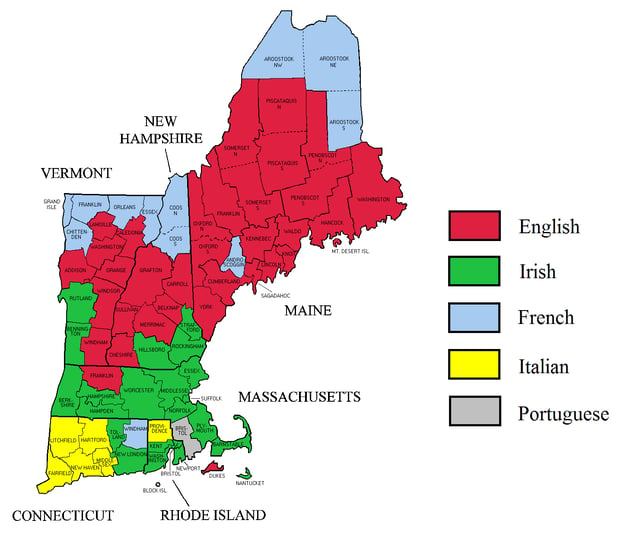
Largest self-reported ancestry groups in New England. Americans of Irish descent form a plurality in most of Massachusetts, while Americans of English descent form a plurality in much of the central parts of Vermont and New Hampshire as well as nearly all of Maine.
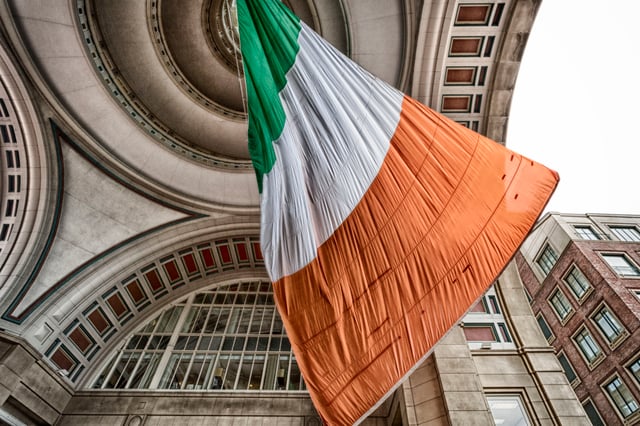
World's largest Irish flag in Boston. People who claim Irish descent constitute the largest ethnic group in New England.
In 2010, New England had a population of 14,444,865, a growth of 3.8% from 2000.[78] This grew to an estimated 14,727,584 by 2015.[79] Massachusetts is the most populous state with 6,794,422 residents, while Vermont is the least populous state with 626,042 residents.[78] Boston is by far the region's most populous city and metropolitan area.
Although a great disparity exists between New England's northern and southern portions, the region's average population density is 234.93 inhabitants/sq mi (90.7/km2). New England has a significantly higher population density than that of the U.S. as a whole (79.56/sq mi), or even just the contiguous 48 states (94.48/sq mi). Three-quarters of the population of New England, and most of the major cities, are in the states of Connecticut, Massachusetts, and Rhode Island. The combined population density of these states is 786.83/sq mi, compared to northern New England's 63.56/sq mi (2000 census).
According to the 2006–08 American Community Survey, 48.7% of New Englanders were male and 51.3% were female. Approximately 22.4% of the population were under 18 years of age; 13.5% were over 65 years of age. The six states of New England have the lowest birth rate in the U.S.[80]
White Americans make up the majority of New England's population at 83.4% of the total population, Hispanic and Latino Americans are New England's largest minority, and they are the second-largest group in the region behind non-Hispanic European Americans. As of 2014, Hispanics and Latinos of any race made up 10.2% of New England's population. Connecticut had the highest proportion at 13.9%, while Vermont had the lowest at 1.3%. There were nearly 1.5 million Hispanic and Latino individuals reported in New England in 2014. Puerto Ricans were the most numerous of the Hispanic and Latino subgroups. Over 660,000 Puerto Ricans lived in New England in 2014, forming 4.5% of the population. The Dominican population is over 200,000, and the Mexican and Guatemalan populations are each over 100,000.[81] Americans of Cuban descent are scant in number; there were roughly 26,000 Cuban Americans in the region in 2014. People of all other Hispanic and Latino ancestries, including Salvadoran, Colombian, and Bolivian, formed 2.5% of New England's population, and numbered over 361,000 combined.[81]
According to the 2014 American Community Survey, the top ten largest reported European ancestries were the following:[82]
Irish: 19.2% (2.8 million)
Italian: 13.6% (2.0 million)
French and French Canadian: 13.1% (1.9 million)
English: 11.9% (1.7 million)[83]
German: 7.4% (1.1 million)
Polish: 4.9% (roughly 715,000)
Portuguese: 3.2% (467,000)
Scottish: 2.5% (370,000)
Russian: 1.4% (206,000)
Greek: 1.0% (152,000)
English is, by far, the most common language spoken at home. Approximately 81.3% of all residents (11.3 million people) over the age of five spoke only English at home. Roughly 1,085,000 people (7.8% of the population) spoke Spanish at home, and roughly 970,000 people (7.0% of the population) spoke other Indo-European languages at home.[84] Over 403,000 people (2.9% of the population) spoke an Asian or Pacific Island language at home.[85] Slightly fewer (about 1%) spoke French at home,[86] although this figure is above 20% in northern New England, which borders francophone Québec. Roughly 99,000 people (0.7% of the population) spoke languages other than these at home.[85]
Southern New England forms an integral part of the BosWash megalopolis, a conglomeration of urban centers that spans from Boston to Washington, D.C. The region includes three of the four most densely populated states in the U.S.; only New Jersey has a higher population density than the states of Rhode Island, Massachusetts, and Connecticut.
Largest cities
[[INLINE_IMAGE|//upload.wikimedia.org/wikipedia/commons/thumb/f/f2/Flag_of_Massachusetts.svg/23px-Flag_of_Massachusetts.svg.png|//upload.wikimedia.org/wikipedia/commons/thumb/f/f2/Flag_of_Massachusetts.svg/35px-Flag_of_Massachusetts.svg.png 1.5x, //upload.wikimedia.org/wikipedia/commons/thumb/f/f2/Flag_of_Massachusetts.svg/46px-Flag_of_Massachusetts.svg.png 2x|Massachusetts|h14|w23|thumbborder flagicon-img flagicon-img]] Boston, Massachusetts: 655,884 (4,739,385)
Worcester, Massachusetts: 183,016 (931,802)
[[INLINE_IMAGE|//upload.wikimedia.org/wikipedia/commons/thumb/f/f3/Flag_of_Rhode_Island.svg/19px-Flag_of_Rhode_Island.svg.png|//upload.wikimedia.org/wikipedia/commons/thumb/f/f3/Flag_of_Rhode_Island.svg/28px-Flag_of_Rhode_Island.svg.png 1.5x, //upload.wikimedia.org/wikipedia/commons/thumb/f/f3/Flag_of_Rhode_Island.svg/37px-Flag_of_Rhode_Island.svg.png 2x|Rhode Island|h17|w19|thumbborder flagicon-img flagicon-img]] Providence, Rhode Island: 179,154 (1,609,533)
Springfield, Massachusetts: 153,991 (630,672)
[[INLINE_IMAGE|//upload.wikimedia.org/wikipedia/commons/thumb/9/96/Flag_of_Connecticut.svg/20px-Flag_of_Connecticut.svg.png|//upload.wikimedia.org/wikipedia/commons/thumb/9/96/Flag_of_Connecticut.svg/30px-Flag_of_Connecticut.svg.png 1.5x, //upload.wikimedia.org/wikipedia/commons/thumb/9/96/Flag_of_Connecticut.svg/39px-Flag_of_Connecticut.svg.png 2x|Connecticut|h15|w20|thumbborder flagicon-img flagicon-img]] Bridgeport, Connecticut: 147,612 (945,816)
New Haven, Connecticut: 130,282 (861,238)
Stamford, Connecticut: 128,278 (part of Bridgeport's MSA)
Hartford, Connecticut: 124,705 (1,213,225)
[[INLINE_IMAGE|//upload.wikimedia.org/wikipedia/commons/thumb/2/28/Flag_of_New_Hampshire.svg/23px-Flag_of_New_Hampshire.svg.png|//upload.wikimedia.org/wikipedia/commons/thumb/2/28/Flag_of_New_Hampshire.svg/35px-Flag_of_New_Hampshire.svg.png 1.5x, //upload.wikimedia.org/wikipedia/commons/thumb/2/28/Flag_of_New_Hampshire.svg/45px-Flag_of_New_Hampshire.svg.png 2x|New Hampshire|h15|w23|thumbborder flagicon-img flagicon-img]] Manchester, New Hampshire: 110,448 (405,339)
Lowell, Massachusetts: 109,945 (part of Greater Boston)
During the 20th century, urban expansion in regions surrounding New York City has become an important economic influence on neighboring Connecticut, parts of which belong to the New York metropolitan area. The U.S. Census Bureau groups Fairfield, New Haven and Litchfield counties in western Connecticut together with New York City, and other parts of New York and New Jersey as a combined statistical area.[92]
Cities and urban areas
Metropolitan areas
The following are metropolitan statistical areas as defined by the United States Census Bureau.
Bangor, ME MSA
Barnstable Town, MA MSA (Greater Boston)
Boston-Cambridge-Newton, MA-NH MSA (Greater Boston)
Bridgeport-Stamford-Norwalk, CT MSA (New York-Newark CSA)
Burlington-South Burlington, VT MSA
Hartford-West Hartford-East Hartford, CT MSA
Lewiston-Auburn, ME MSA
Manchester-Nashua, NH MSA
New Haven-Milford, CT MSA (New York-Newark CSA)
Norwich-New London, CT MSA
Pittsfield, MA MSA
Portland-South Portland, ME MSA
Springfield, MA MSA
Providence-Warwick, RI-MA MSA (Greater Boston)
Worcester, MA-CT MSA (Greater Boston)
State capitals
Hartford, Connecticut
Augusta, Maine
Boston, Massachusetts
Concord, New Hampshire
Providence, Rhode Island
Montpelier, Vermont
Economy
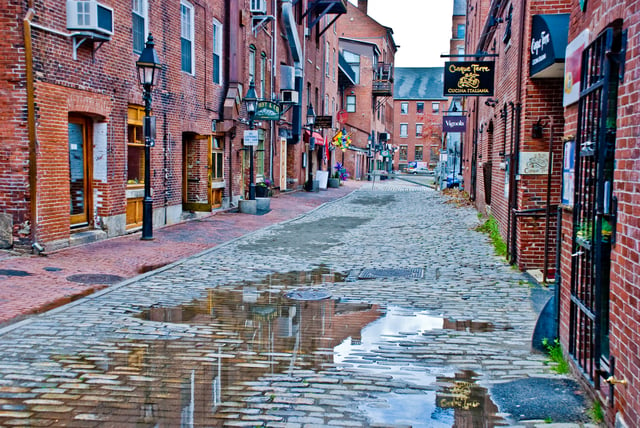
Old Port (Wharf Street) in Portland, Maine
Several factors combine to make the New England economy unique. The region is distant from the geographic center of the country, and it is a relatively small region but densely populated. It historically has been an important center of industry and manufacturing and a supplier of natural resource products, such as granite, lobster, and codfish. The service industry is important, including tourism, education, financial and insurance services, and architectural, building, and construction services. The U.S. Department of Commerce has called the New England economy a microcosm for the entire U.S. economy.[93]
The region underwent a long period of deindustrialization in the first half of the 20th century, as traditional manufacturing companies relocated to the Midwest, with textile and furniture manufacturing migrating to the South. In the late-20th century, an increasing portion of the regional economy included high technology, military defense industry, finance and insurance services, and education and health services. As of 2015, the GDP of New England was $953.9 billion.[94]
New England exports food products ranging from fish to lobster, cranberries, potatoes, and maple syrup. About half of the region's exports consist of industrial and commercial machinery, such as computers and electronic and electrical equipment. Granite is quarried at Barre, Vermont,[95] guns made at Springfield, Massachusetts and Saco, Maine, submarines at Groton, Connecticut, surface naval vessels at Bath, Maine, and hand tools at Turners Falls, Massachusetts.
Urban centers
In 2017, Boston was ranked as having the ninth-most competitive financial center in the world and the fourth-most competitive in the United States.[96] Boston-based Fidelity Investments helped popularize the mutual fund in the 1980s and has made Boston one of the top financial centers in the United States.[97][98] The city is home to the headquarters of Santander Bank and a center for venture capital firms. State Street Corporation specializes in asset management and custody services and is based in the city.
Boston is also a printing and publishing center.[99] Houghton Mifflin Harcourt is headquartered there, along with Bedford-St. Martin's and Beacon Press. The city is also home to the Hynes Convention Center in the Back Bay, and the Seaport Hotel and Seaport World Trade Center and Boston Convention and Exhibition Center on the South Boston waterfront.[100]
The General Electric Corporation announced its decision to move the company's global headquarters to the Boston Seaport District from Fairfield, Connecticut in 2016, citing factors including Boston's preeminence in the realm of higher education.[101] The city also holds the headquarters to several major athletic and footwear companies, including Converse, New Balance, and Reebok. Rockport, Puma, and Wolverine World Wide have headquarters or regional offices[102] just outside the city.[103]
Hartford is the historic international center of the insurance industry, with companies such as Aetna, Conning & Company, The Hartford, Harvard Pilgrim Health Care, The Phoenix Companies, and Hartford Steam Boiler based in the city, and The Travelers Companies and Lincoln National Corporation have major operations in the city. It is also home to the corporate headquarters of U.S. Fire Arms Mfg. Co., United Technologies, and Virtus Investment Partners.[104]
Fairfield County, Connecticut has a large concentration of investment management firms in the area, most notably Bridgewater Associates (one of the world's largest hedge fund companies), Aladdin Capital Management, and Point72 Asset Management. Moreover, many international banks have their North American headquarters in Fairfield County, such as Royal Bank of Scotland Group and UBS.
Agriculture
Agriculture is limited by the area's rocky soil, cool climate, and small area. Some New England states, however, are ranked highly among U.S. states for particular areas of production. Maine is ranked ninth for aquaculture,[105] and has abundant potato fields in its northeast part. Vermont is fifteenth for dairy products,[106] and Connecticut and Massachusetts seventh and eleventh for tobacco, respectively.[107][108] Cranberries are grown in Massachusetts' Cape Cod-Plymouth-South Shore area, and blueberries in Maine.
Energy
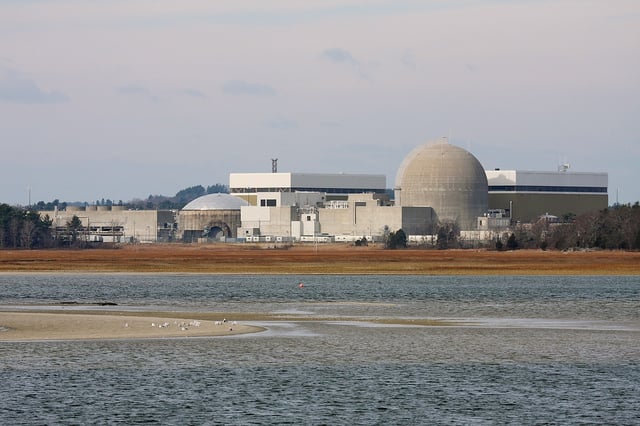
Seabrook Station Nuclear Power Plant in Seabrook, New Hampshire
Employment
| Employment area | October 2010 | October 2011 | October 2012 | October 2013 | December 2014 | December 2015[111] | December 2016[112] | Net change |
|---|---|---|---|---|---|---|---|---|
| United States | 9.7 | 9.0 | 7.9 | 7.2 | 5.6 | 5.0 | 4.7 | −5.0 |
| New England | 8.3 | 7.6 | 7.4 | 7.1 | 5.4 | 4.3 | 3.5 | −4.7 |
| Connecticut | 9.1 | 8.7 | 9.0 | 7.6 | 6.4 | 5.2 | 4.4 | −4.7 |
| Maine | 7.6 | 7.3 | 7.4 | 6.5 | 5.5 | 4.0 | 3.8 | −3.8 |
| Massachusetts | 8.3 | 7.3 | 6.6 | 7.2 | 5.5 | 4.7 | 2.8 | −5.5 |
| New Hampshire | 5.7 | 5.3 | 5.7 | 5.2 | 4.0 | 3.1 | 2.6 | −3.1 |
| Rhode Island | 11.5 | 10.4 | 10.4 | 9.4 | 6.8 | 5.1 | 5.0 | −6.5 |
| Vermont | 5.9 | 5.6 | 5.5 | 4.4 | 4.2 | 3.6 | 3.1 | −2.8 |
As of January 2017, employment is stronger in New England than in the rest of the United States. During the Great Recession, unemployment rates ballooned across New England as elsewhere; however, in the years that followed, these rates declined steadily, with New Hampshire and Massachusetts having the lowest unemployment rates in the country, respectively. The most extreme swing was in Rhode Island, which had an unemployment rate above 10% following the recession, but which saw this rate decline by over 6% in six years.
As of December 2016, the metropolitan statistical area (MSA) with the lowest unemployment rate, 2.1%, was Burlington-South Burlington, Vermont; the MSA with the highest rate, 4.9%, was Waterbury, Connecticut.[113]
Overall tax burden
In 2018, four of the six New England states were among the top ten states in the country in terms of taxes paid per taxpayer. The rankings included #3 Maine (11.02%), #4 Vermont (10.94%), #6 Connecticut (10.19%), and #7 Rhode Island (10.14%). Additionally New Hampshire, Vermont, Maine and Rhode Island took four of the top five spots for "Highest Property Tax as a Percentage of Personal Income".[114]
Government
Town meetings

A New England town meeting in Huntington, Vermont

Flag of the New England Governor's Conference, which uses a blue field instead of the traditional red.
New England town meetings were derived from meetings held by church elders, and are still an integral part of government in many New England towns. At such meetings, any citizen of the town may discuss issues with other members of the community and vote on them. This is the strongest example of direct democracy in the U.S. today, and the strong democratic tradition was even apparent in the early 19th century, when Alexis de Tocqueville wrote in Democracy in America:
By contrast, James Madison wrote in Federalist No. 55 that, regardless of the assembly, "passion never fails to wrest the scepter from reason. Had every Athenian citizen been a Socrates, every Athenian assembly would still have been a mob."[116] The use and effectiveness of town meetings is still discussed by scholars, as well as the possible application of the format to other regions and countries.[117]
Politics
Elections

Flag of the New England Governor's Conference (NEGC)
State and national elected officials in New England recently have been elected mainly from the Democratic Party.[118] The region is generally considered to be the most liberal in the United States, with more New Englanders identifying as liberals than Americans elsewhere. In 2010, four of six of the New England states were polled as the most liberal in the United States.[119]
The six states of New England voted for the Democratic presidential nominee in the 1992, 1996, 2004, 2008, 2012, and 2016 elections, and every New England state other than New Hampshire voted for Al Gore in the presidential election of 2000. In the 113th Congress, the House delegations from all six states of New England were all Democratic. New England is home to the only two independents currently serving in the Senate, both of whom caucus with the Democratic Party: Bernie Sanders, a self-described democratic socialist,[120][121] representing Vermont, and Angus King, an Independent representing Maine.
In the 2008 presidential election, Barack Obama carried all six New England states by 9 percentage points or more.[122] He carried every county in New England except for Piscataquis County, Maine, which he lost by 4% to Senator John McCain (R-AZ). Pursuant to the reapportionment following the 2010 census, New England collectively has 33 electoral votes.
The following table presents the vote percentage for the popular-vote winner for each New England state, New England as a whole, and the United States as a whole, in each presidential election from 1900 to 2016, with the vote percentage for the Republican candidate shaded in red and the vote percentage for the Democratic candidate shaded in blue:
| Year | Connecticut | Maine | Massachusetts | New Hampshire | Rhode Island | Vermont | New England | United States |
|---|---|---|---|---|---|---|---|---|
| 2016 | 54.6% | 47.8% | 60.0% | 46.8% | 54.4% | 56.7% | 55.3% | 48.2% |
| 2012 | 58.1% | 56.3% | 60.7% | 52.0% | 62.7% | 66.6% | 59.1% | 51.1% |
| 2008 | 60.6% | 57.7% | 61.8% | 54.1% | 62.9% | 67.5% | 60.6% | 52.9% |
| 2004 | 54.3% | 53.6% | 61.9% | 50.2% | 59.4% | 58.9% | 57.7% | 50.7% |
| 2000 | 55.9% | 49.1% | 59.8% | 48.1% | 61.0% | 50.6% | 56.1% | 48.4% |
| 1996 | 52.8% | 51.6% | 61.5% | 49.3% | 59.7% | 53.4% | 56.8% | 49.2% |
| 1992 | 42.2% | 38.8% | 47.5% | 38.9% | 47.0% | 46.1% | 44.4% | 43.0% |
| 1988 | 52.0% | 55.3% | 53.2% | 62.5% | 55.6% | 51.1% | 49.5% | 53.4% |
| 1984 | 60.7% | 60.8% | 51.2% | 68.7% | 51.7% | 57.9% | 56.2% | 58.8% |
| 1980 | 48.2% | 45.6% | 41.9% | 57.7% | 47.7% | 44.4% | 44.7% | 50.8% |
| 1976 | 52.1% | 48.9% | 56.1% | 54.7% | 55.4% | 54.3% | 51.7% | 50.1% |
| 1972 | 58.6% | 61.5% | 54.2% | 64.0% | 53.0% | 62.7% | 52.5% | 60.7% |
| 1968 | 49.5% | 55.3% | 63.0% | 52.1% | 64.0% | 52.8% | 56.1% | 43.4% |
| 1964 | 67.8% | 68.8% | 76.2% | 63.9% | 80.9% | 66.3% | 72.8% | 61.1% |
| 1960 | 53.7% | 57.0% | 60.2% | 53.4% | 63.6% | 58.6% | 56.0% | 49.7% |
| 1956 | 63.7% | 70.9% | 59.3% | 66.1% | 58.3% | 72.2% | 62.0% | 57.4% |
| 1952 | 55.7% | 66.0% | 54.2% | 60.9% | 50.9% | 71.5% | 56.1% | 55.2% |
| 1948 | 49.5% | 56.7% | 54.7% | 52.4% | 57.6% | 61.5% | 51.5% | 49.6% |
| 1944 | 52.3% | 52.4% | 52.8% | 52.1% | 58.6% | 57.1% | 52.4% | 53.4% |
| 1940 | 53.4% | 51.1% | 53.1% | 53.2% | 56.7% | 54.8% | 52.8% | 54.7% |
| 1936 | 55.3% | 55.5% | 51.2% | 49.7% | 53.1% | 56.4% | 50.9% | 60.8% |
| 1932 | 48.5% | 55.8% | 50.6% | 50.4% | 55.1% | 57.7% | 49.1% | 57.4% |
| 1928 | 53.6% | 68.6% | 50.2% | 58.7% | 50.2% | 66.9% | 53.2% | 58.2% |
| 1924 | 61.5% | 72.0% | 62.3% | 59.8% | 59.6% | 78.2% | 63.3% | 54.0% |
| 1920 | 62.7% | 68.9% | 68.5% | 59.8% | 64.0% | 75.8% | 66.7% | 60.3% |
| 1916 | 49.8% | 51.0% | 50.5% | 49.1% | 51.1% | 62.4% | 51.1% | 49.2% |
| 1912 | 39.2% | 39.4% | 35.5% | 39.5% | 39.0% | 37.1% | 36.6% | 41.8% |
| 1908 | 59.4% | 63.0% | 58.2% | 59.3% | 60.8% | 75.1% | 60.2% | 51.6% |
| 1904 | 58.1% | 67.4% | 57.9% | 60.1% | 60.6% | 78.0% | 60.4% | 56.4% |
| 1900 | 56.9% | 61.9% | 57.6% | 59.3% | 59.7% | 75.7% | 59.4% | 51.6% |
Political party strength
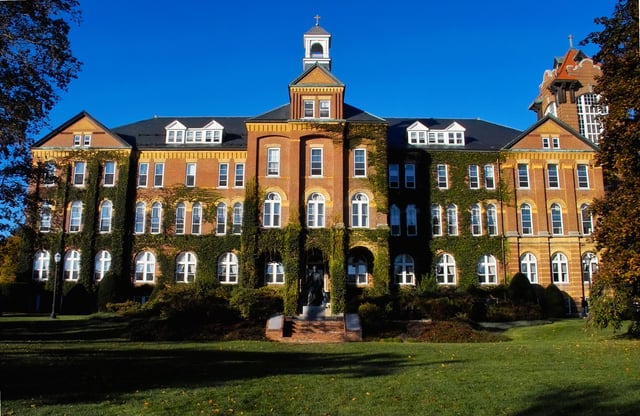
Alumni Hall at Saint Anselm College has served as a backdrop for the media reports during the New Hampshire primary.
Judging purely by party registration rather than voting patterns, New England today is one of the most Democratic regions in the U.S.[123][124][125] According to Gallup, Connecticut, Massachusetts, Rhode Island, and Vermont are "solidly Democratic", Maine "leans Democratic", and New Hampshire is a swing state.[126] Though New England is today considered a Democratic Party stronghold, much of the region was staunchly Republican before the mid-twentieth century. This changed in the late 20th century, in large part due to demographic shifts[127] and the Republican Party's adoption of socially conservative platforms as part of their strategic shift towards the South.[60] For example, Vermont voted Republican in every presidential election but one from 1856 through 1988, and has voted Democratic every election since. Maine and Vermont were the only two states in the nation to vote against Democrat Franklin D. Roosevelt all four times he ran for president. Republicans in New England are today considered by both liberals and conservatives to be more moderate (socially liberal) compared to Republicans in other parts of the U.S.[128]
- **†**Elected as an independent, but caucuses with the Democratic Party.
| State | Governor | Senior U.S. Senator | Junior U.S. Senator | U.S. House Delegation | Upper House Majority | Lower House Majority |
|---|---|---|---|---|---|---|
| CT | N. Lamont | R. Blumenthal | C. Murphy | Democratic 5–0 | Democratic 21–13 | Democratic 92–59 |
| ME | J. Mills | S. Collins | A. King[†] | Democratic 2-0 | Democratic 21–14 | Democratic 88–56–6 |
| MA | C. Baker | E. Warren | E. Markey | Democratic 9–0 | Democratic 34–6 | Democratic 127–32 |
| NH | C. Sununu | J. Shaheen | M. Hassan | Democratic 2-0 | Democratic 14–10 | Democratic 233-167 |
| RI | G. Raimondo | J. Reed | S. Whitehouse | Democratic 2–0 | Democratic 33–5 | Democratic 66-9 |
| VT | P. Scott | P. Leahy | B. Sanders[†] | Democratic 1–0 | Democratic 21–7–2 | Democratic 83–53–7–7 |
New Hampshire primary
Historically, the New Hampshire primary has been the first in a series of nationwide political party primary elections held in the United States every four years. Held in the state of New Hampshire, it usually marks the beginning of the U.S. presidential election process. Even though few delegates are chosen from New Hampshire, the primary has always been pivotal to both New England and American politics. One college in particular, Saint Anselm College, has been home to numerous national presidential debates and visits by candidates to its campus.[129]
Education
Colleges and universities
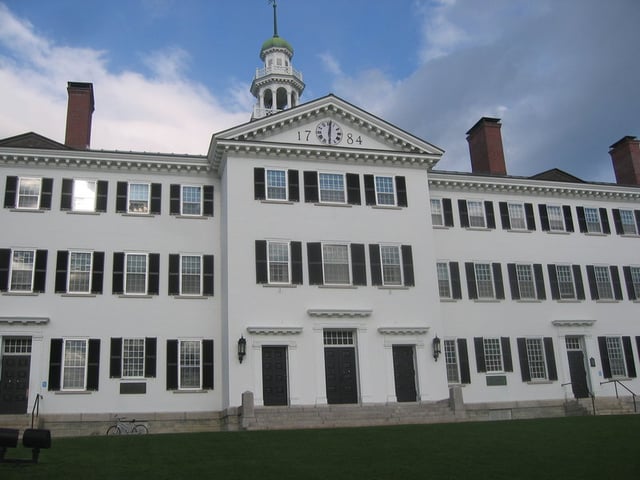
New England is home to four of the eight Ivy League universities. Pictured here is Dartmouth Hall on the campus of Dartmouth College.
New England contains some of the oldest and most renowned institutions of higher learning in the United States and the world. Harvard College was the first such institution, founded in 1636 at Cambridge, Massachusetts to train preachers. Yale University was founded in Saybrook, Connecticut in 1701, and awarded the nation's first doctoral (PhD) degree in 1861. Yale moved to New Haven, Connecticut in 1718, where it has remained to the present day.
Brown University was the first college in the nation to accept students of all religious affiliations, and is the seventh oldest U.S. institution of higher learning. It was founded in Providence, Rhode Island in 1764. Dartmouth College was founded five years later in Hanover, New Hampshire with the mission of educating the local American Indian population as well as English youth. The University of Vermont, the fifth oldest university in New England, was founded in 1791, the same year that Vermont joined the Union.
In addition to four out of eight Ivy League schools, New England contains the Massachusetts Institute of Technology (MIT), the bulk of educational institutions that are identified as the "Little Ivies", four of the original Seven Sisters, one of the eight original Public Ivies, the Colleges of Worcester Consortium in central Massachusetts, and the Five Colleges consortium in western Massachusetts. The University of Maine, the University of New Hampshire, the University of Connecticut, the University of Massachusetts at Amherst, the University of Rhode Island, and the University of Vermont are the flagship state universities in the region.
Private and independent secondary schools
At the pre-college level, New England is home to a number of American independent schools (also known as private schools). The concept of the elite "New England prep school" (preparatory school) and the "preppy" lifestyle is an iconic part of the region's image.[130]
- See the list of private schools for each state:
Connecticut,Massachusetts,Maine,New Hampshire,Rhode Island,Vermont.
Public education

Boston Latin School is the oldest public school in the U.S., established in 1635.
As of 2005, the National Education Association ranked Connecticut as having the highest-paid teachers in the country. Massachusetts and Rhode Island ranked eighth and ninth, respectively.
New Hampshire, Rhode Island, and Vermont have cooperated in developing a New England Common Assessment Program test under the No Child Left Behind guidelines. These states can compare the resultant scores with each other.
The Maine Learning Technology Initiative program supplies all students with Apple MacBook laptops.
Academic journals and press
There are several academic journals and publishing companies in the region, including The New England Journal of Medicine, Harvard University Press, and Yale University Press. Some of its institutions lead the open access alternative to conventional academic publication, including MIT, the University of Connecticut, and the University of Maine. The Federal Reserve Bank of Boston publishes the New England Economic Review.[133]
Culture
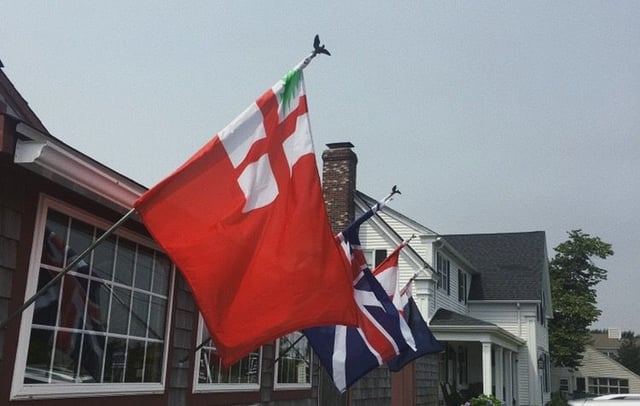
Flag of New England flying in Massachusetts. New Englanders maintain a strong sense of regional and cultural identity.[134]
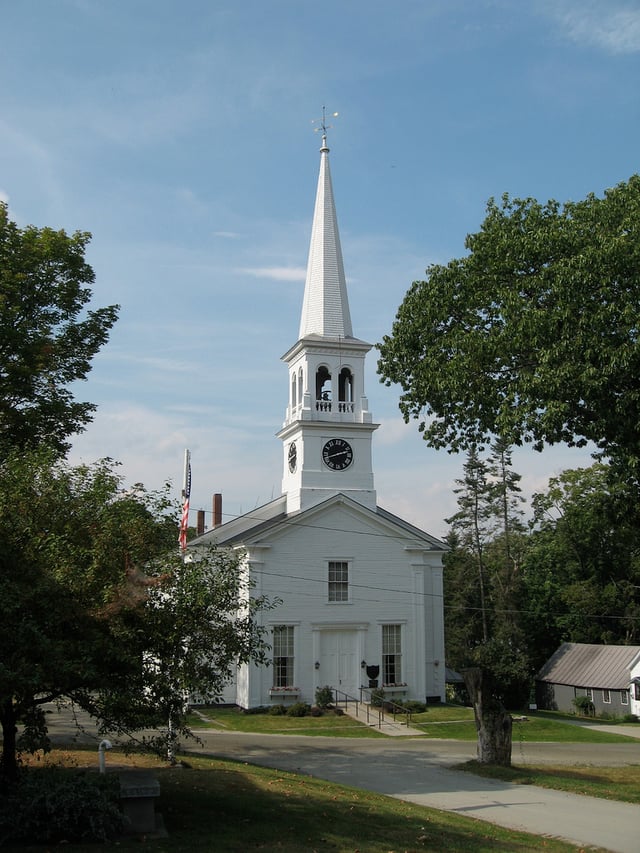
A classic New England Congregational church in Peacham, Vermont
New England has a shared heritage and culture primarily shaped by waves of immigration from Europe.[135] In contrast to other American regions, many of New England's earliest Puritan settlers came from eastern England, contributing to New England's distinctive accents, foods, customs, and social structures.[136] [] Within modern New England a cultural divide exists between urban New Englanders living along the densely populated coastline, and rural New Englanders in western Massachusetts, northwestern and northeastern Connecticut, Vermont, New Hampshire, and Maine, where population density is low.[137]
Today, New England is the least religious region of the U.S. In 2009, less than half of those polled in Maine, Massachusetts, New Hampshire, and Vermont claimed that religion was an important part of their daily lives. In Connecticut and Rhode Island, also among the ten least religious states, 55 and 53%, respectively, of those polled claimed that it was.[138] According to the American Religious Identification Survey, 34% of Vermonters, a plurality, claimed to have no religion; on average, nearly one out of every four New Englanders identifies as having no religion, more than in any other part of the U.S.[139] New England had one of the highest percentages of Catholics in the U.S. This number declined from 50% in 1990 to 36% in 2008.[139]
Cultural roots
Many of the first European colonists of New England had a maritime orientation toward whaling (first noted about 1650)[140] and fishing, in addition to farming. New England has developed a distinct cuisine, dialect, architecture, and government. New England cuisine has a reputation for its emphasis on seafood and dairy; clam chowder, lobster, and other products of the sea are among some of the region's most popular foods.
New England has largely preserved its regional character, especially in its historic places. The region has become more ethnically diverse, having seen waves of immigration from Ireland, Quebec, Italy, Portugal, Germany, Poland, Scandinavia, Asia, Latin America, Africa, other parts of the U.S., and elsewhere. The enduring European influence can be seen in the region in the use of traffic rotaries, the bilingual French and English towns of northern Vermont, Maine, and New Hampshire, the region's heavy prevalence of English town- and county-names, and its unique, often non-rhotic coastal dialect reminiscent of southeastern England.
Within New England, many names of towns (and a few counties) repeat from state to state, primarily due to settlers throughout the region having named their new towns after their old ones. For example, the town of North Yarmouth, Maine was named by settlers from Yarmouth, Massachusetts, which was in turn named for Great Yarmouth in England. As another example, every New England state has a town named Warren, and every state except Rhode Island has a city or town named Andover, Bridgewater, Chester, Franklin, Manchester, Plymouth, Washington, and Windsor; in addition, every state except Connecticut has a Lincoln and a Richmond, and Massachusetts, Vermont, and Maine each contains a Franklin County.
Cuisine

Cranberry sauce

Coffee Regular

Clam chowder
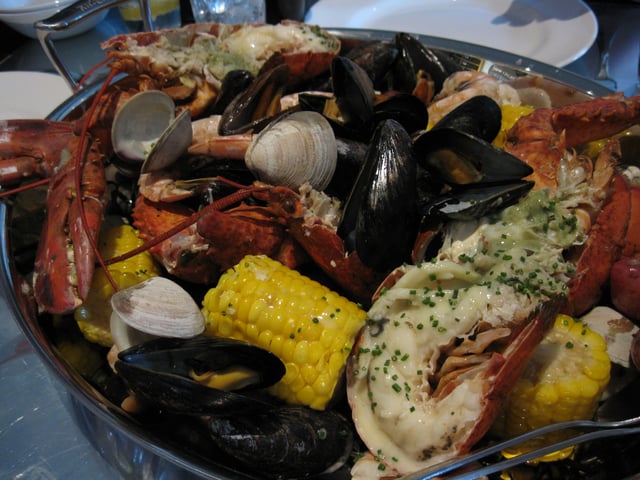
Clam Bake
New England maintains a distinct cuisine and food culture. Early foods in the region were influenced by Indian and English cuisines. The early colonists often adapted their original cuisine to fit with the available foods of the region. New England staples such as johnnycakes, succotash, cornbread, and various seafood recipes reflect the convergence of Indian and Pilgrim cuisine.
New England also has a distinct food language. A few of the unique regional terms include "grinders" for submarine sandwiches and "frappes" for thick milkshakes, referred to as "Cabinets" in Rhode Island. Other foods native to the region include steak tips (marinated sirloin steak), bulkie rolls, maple syrup, cranberry recipes, and clam chowder.[141]
Accents and dialects
There are several American English dialects spoken in the region (normally north of Connecticut), including New England English and its derivative known as the Boston accent,[144] which is native to the northeastern coastal regions of New England. The most identifiable features of the Boston accent are believed to have originated from England's Received Pronunciation, which shares features such as the broad A and dropping the final R. Another source was 17th century speech in East Anglia and Lincolnshire, where many of the Puritan immigrants had originated. The East Anglian "whine" developed into the Yankee "twang".[136] Boston accents were most strongly associated at one point with the so-called "Eastern Establishment" and Boston's upper class, although today the accent is predominantly associated with blue-collar natives, as exemplified by movies such as Good Will Hunting and The Departed. The Boston accent and those accents closely related to it cover eastern Massachusetts, New Hampshire, and Maine.[145]
Some Rhode Islanders speak with a non-rhotic accent that many compare to a "Brooklyn" accent or a cross between a New York and Boston accent, where "water" becomes "wata". Many Rhode Islanders distinguish the aw sound [ɔː], as one might hear in New Jersey; e.g., the word "coffee" is pronounced /ˈkɔːfi/ KAW-fee.[146] This type of accent was brought to the region by early settlers from eastern England in the Puritan migration in the mid-seventeenth century.[136] []
Social activities and music
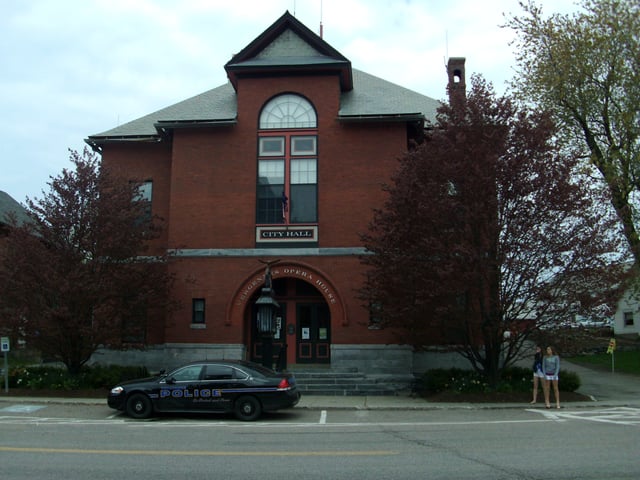
Opera houses and theaters are popular in New England towns, such as the Vergennes Opera House in Vergennes, Vermont.
Acadian and Québécois culture are included in music and dance in much of rural New England, particularly Maine. Contra dancing and country square dancing are popular throughout New England, usually backed by live Irish, Acadian, or other folk music. Fife and drum corps are common, especially in southern New England and more specifically Connecticut, with music of mostly Celtic, English, and local origin.
Traditional knitting, quilting, and rug hooking circles in rural New England have become less common; church, sports, and town government are more typical social activities. These traditional gatherings are often hosted in individual homes or civic centers.
New England was an important center of American classical music for some time. Prominent modernist composers also come from the region, including Charles Ives and John Adams. Boston is the site of the New England Conservatory and the Boston Symphony Orchestra.
In popular music, the region has produced Donna Summer, JoJo, New Edition, Bobby Brown, Passion Pit, Meghan Trainor, New Kids on the Block, Rachel Platten, and John Mayer. In rock music, the region has produced Rob Zombie, Aerosmith, The Modern Lovers, Phish, the Pixies, Grace Potter, GG Allin, the Dropkick Murphys, and Boston. Quincy, Massachusetts native Dick Dale helped popularize surf rock.
Media
The leading U.S. cable TV sports broadcaster ESPN is headquartered in Bristol, Connecticut. New England has several regional cable networks, including New England Cable News (NECN) and the New England Sports Network (NESN). New England Cable News is the largest regional 24-hour cable news network in the U.S., broadcasting to more than 3.2 million homes in all of the New England states. Its studios are located in Newton, Massachusetts, outside of Boston, and it maintains bureaus in Manchester, New Hampshire; Hartford, Connecticut; Worcester, Massachusetts; Portland, Maine; and Burlington, Vermont.[150] In Connecticut, Litchfield, Fairfield, and New Haven counties it also broadcasts New York based news programs—this is due in part to the immense influence New York has on this region's economy and culture, and also to give Connecticut broadcasters the ability to compete with overlapping media coverage from New York-area broadcasters.
NESN broadcasts the Boston Red Sox baseball and Boston Bruins hockey throughout the region, save for Fairfield County, Connecticut.[151] Southern Rhode Island and most of Connecticut, save for Windham County in the state's northeast corner, receive the YES Network, which broadcasts the games of the New York Yankees. For the most part, the same areas also carry SportsNet New York (SNY), which broadcasts New York Mets games.
Comcast SportsNet New England broadcasts the games of the Boston Celtics, New England Revolution and Boston Cannons.
While most New England cities have daily newspapers, The Boston Globe and The New York Times are distributed widely throughout the region. Major newspapers also include The Providence Journal, Portland Press Herald, and Hartford Courant, the oldest continuously published newspaper in the U.S.[152]
Comedy
New Englanders are well represented in American comedy. Writers for The Simpsons and late-night television programs often come by way of the Harvard Lampoon. Family Guy is an animated sitcom situated in Rhode Island, created by Connecticut native and Rhode Island School of Design graduate Seth MacFarlane (along with American Dad! and The Cleveland Show). A number of Saturday Night Live (SNL) cast members have roots in New England, from Adam Sandler to Amy Poehler, who also starred in the NBC television series Parks and Recreation. Former Daily Show correspondents John Hodgman, Rob Corddry and Steve Carell are from Massachusetts. Carell was also involved in film and the American adaptation of The Office, which features Dunder-Mifflin branches set in Stamford, Connecticut and Nashua, New Hampshire.
Late-night television hosts Jay Leno and Conan O'Brien have roots in the Boston area. Notable stand-up comedians are also from the region, including Bill Burr, Steve Sweeney, Steven Wright, Sarah Silverman, Lisa Lampanelli, Denis Leary, Lenny Clarke, Patrice O'Neal, and Louis CK. SNL cast member Seth Meyers once attributed the region's imprint on American humor to its "sort of wry New England sense of pointing out anyone who's trying to make a big deal of himself", with the Boston Globe suggesting that irony and sarcasm are its trademarks, as well as Irish influences.[153]
Literature
New Englanders have made significant contributions to literature. The first printing press in America was set up in Cambridge, Massachusetts by Stephen Daye in the 17th century. Writers in New England produced many works on religious subjects, particularly on Puritan theology and poetry during colonial times and on Enlightenment ideas during the American Revolution. The literature of New England has had an enduring influence on American literature in general, with themes that are emblematic of the larger concerns of American letters, such as religion, race, the individual versus society, social repression, and nature.[156]
19th century New England was a center for progressive ideals, and many abolitionist and transcendentalist tracts were produced. Leading transcendentalists were from New England, such as Henry David Thoreau, Ralph Waldo Emerson, and Frederic Henry Hedge. Hartford, Connecticut resident Harriet Beecher Stowe's novel Uncle Tom's Cabin was an influential book in the spread of abolitionist ideas and is said to have "laid the groundwork for the Civil War".[157] Other prominent New England novelists include John Irving, Edgar Allan Poe, Louisa May Alcott, Sarah Orne Jewett, H. P. Lovecraft, Annie Proulx, Steven King, Jack Kerouac, George V. Higgins, and Nathaniel Hawthorne.
Boston was the center of the American publishing industry for some years, largely on the strength of its local writers and before it was overtaken by New York in the middle of the nineteenth century. Boston remains the home of publishers Houghton Mifflin and Pearson Education, and it was the longtime home of literary magazine The Atlantic Monthly. Merriam-Webster is based in Springfield, Massachusetts. Yankee is a magazine for New Englanders based in Dublin, New Hampshire.
Many New Englander poets have also been preeminent in American poetry. Prominent poets include Henry Wadsworth Longfellow, David Lindsay-Abaire, Annie Proulx, Edwin Arlington Robinson, Amy Lowell, John Cheever, Emily Dickinson, Elizabeth Bishop, Stanley Kunitz, E. E. Cummings, Edna St. Vincent Millay, Robert P. T. Coffin, and Richard Wilbur. Robert Frost who was descibred as an "artistic institution"[158] frequently wrote about rural New England life. The Confessional poetry movement features prominent New England writers including Robert Lowell, Anne Sexton, and Sylvia Plath.
Film, television, and acting
New England has a rich history in filmmaking dating back to the dawn of the motion picture era at the turn of the 20th century, sometimes dubbed Hollywood East by film critics. A theater at 547 Washington Street in Boston was the second location to debut a picture projected by the Vitascope, and shortly thereafter several novels were being adapted for the screen and set in New England, including The Scarlet Letter and The House of Seven Gables.[159] The New England region continued to churn out films at a pace above the national average for the duration of the 20th century, including blockbuster hits such as Jaws, Good Will Hunting, and The Departed, all of which won Academy Awards. The New England area became known for a number of themes that recurred in films made during this era, including the development of yankee characters, smalltown life contrasted with city values, seafaring tales, family secrets, and haunted New England.[160] These themes are rooted in centuries of New England culture and are complemented by the region's diverse natural landscape and architecture, from the Atlantic Ocean and brilliant fall foliage to church steeples and skyscrapers.
Since the turn of the millennium, Boston and the greater New England region have been home to the production of numerous films and television series, thanks in part to tax incentive programs put in place by local governments to attract filmmakers to the region.[161]
Notable actors and actresses that have come from the New England area include Ben Affleck, Matt Damon, Amy Poehler, Elizabeth Banks, Steve Carell, Ruth Gordon, John Krasinski, Edward Norton, Mark Wahlberg, and Matthew Perry. A full list of those from Massachusetts can be found here, and a listing of notable films and television series produced in the area here.
Museums, historical societies, and libraries
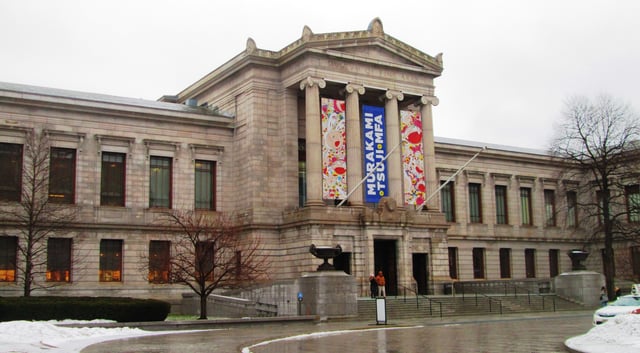
Museum of Fine Arts, Boston
There are many museums located throughout New England, especially in the Greater Boston area. These museums include privately held collections as well as public institutions. Most notable of these museums are the Museum of Fine Arts, the Institute of Contemporary Art, Boston, the Isabella Stewart Gardner Museum, and the Peabody Essex Museum. The oldest public museum in continuous operation in the United States is the Pilgrim Hall Museum in Plymouth, Massachusetts, which opened in 1824.
The Boston Public Library is the largest public library in the region with over 8 million materials in its collection. The largest academic research library in the world is the Harvard Library in Cambridge, Massachusetts. The W. E. B. Du Bois Library of the University of Massachusetts Amherst is the tallest academic library in the world.[162]
There are also many historical societies in the region. Historic New England operates museums and historic sites in the name of historical preservation. Many properties belonging to HNE include preserved house museums of prominent figures in New England and American history. Other societies include the Massachusetts Historical Society, the Essex Institute, the American Antiquarian Society, and The Bostonian Society. The Massachusetts Historical Society, founded in 1791, is the oldest operating in the United States.[163] Many cities and towns across New England operate their own historical societies focused on historical preservation of local sites and the recording of local history.
Sports
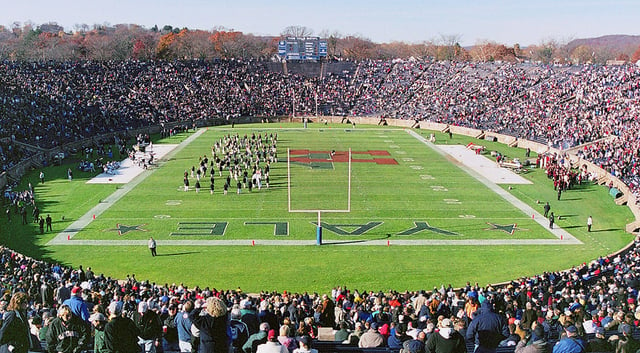
Harvard vs. Yale football game in 2003

Fenway Park
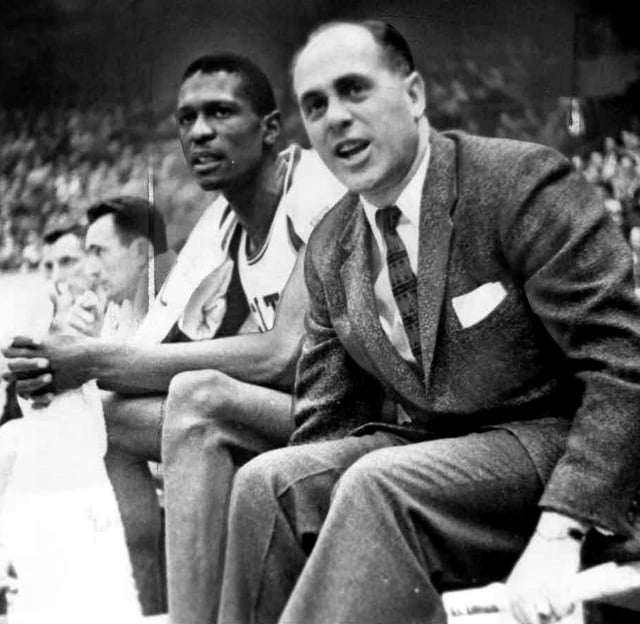
Bill Russell and Red Auerbach of the Boston Celtics.
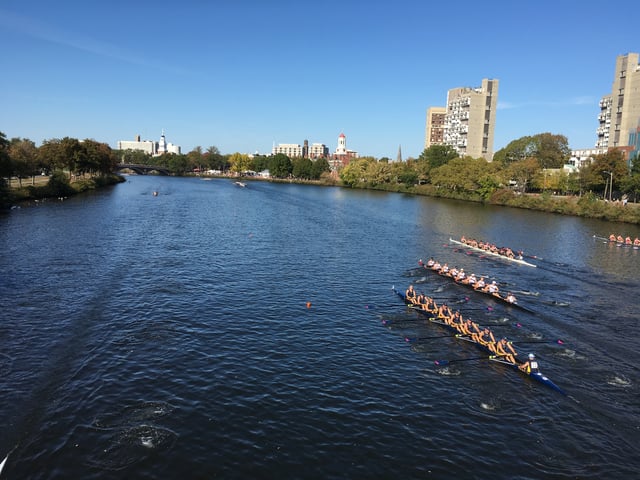
Head of the Charles Regatta in 2017
New England has a strong heritage of athletics, with many now internationally popular sports having been invented and codified in the region. Sports developed in New England include basketball, volleyball, and American football.
Football is the most popular sport in the region and was developed by Walter Camp in New Haven, Connecticut, in the 1870s and 1880s. The New England Patriots, based in Foxborough, Massachusetts, are the most popular professional sports team in New England. The Patriots have won six Super Bowl championships and are one of the most winning teams in the National Football League. There are also high-profile collegiate and high school football rivalries in New England. These games, most often played on Thanksgiving Day are some of the oldest rivalries in the United States. The Harvard University and Yale University football rivalry, dubbed "The Game", is the third most played NCAA Division I rivalry. The high school rivalry between Wellesley High School and Needham High School in Massachusetts is considered to be the nation's oldest football rivalry, having started in 1882.[164][165][166][167]
Baseball is considered to be one of New England's most beloved pastimes. Before the advent of its modern rules a different form of baseball was played. Called the Massachusetts Game, this version of baseball was an early rival of the Knickerbocker Rules of New York and was played throughout New England. In 1869 there were 59 teams throughout the region which played according to the Massachusetts rules. When the New York rules became more popular throughout the United States, professional and semi-professional clubs began to appear. Early teams such as the Providence Grays, the Worcester Worcesters, and the Hartford Dark Blues did not last long, but other teams such as the Boston Braves and the Boston Red Sox grew to renown. The Red Sox and their home field Fenway Park are some of the most storied institutions in professional baseball in America. Fenway Park, built in 1912, has been called a "shrine" and is the oldest ballpark still in use in Major League Baseball.[168] The Yankees–Red Sox rivalry is considered one of the most famous sports rivalries in the world. Other professional baseball teams in the region include the Hartford Yard Goats, Lowell Spinners, New Hampshire Fisher Cats, Vermont Lake Monsters, Portland Sea Dogs, Bridgeport Bluefish, New Britain Bees, and the Pawtucket Red Sox.[169][170]
Basketball was first developed in Springfield, Massachusetts, by James Naismith in 1891. Naismith was attempting to create a game which could be played indoors so athletes could keep fit during New England winters. Becoming one of the most popular sports in the world, basketball is also the official sport of Massachusetts. The Boston Celtics, founded in 1946, is the most successful NBA team, winning 17 titles. The NBA G League team the Maine Red Claws is based in Portland, Maine. The Women's National Basketball Association's Connecticut Sun is based in Uncasville, Connecticut. The Springfield Armor in Springfield, Massachusetts, previously played in the region. The Red Claws are affiliated with the Boston Celtics, and the Armor were affiliated with the Brooklyn Nets, prior to relocating to Grand Rapids, Michigan, to become the Grand Rapids Drive. New England was also represented in the Premier Basketball League by the Vermont Frost Heaves of Barre, Vermont, until they folded in 2011. The UConn Huskies women's basketball team is the most successful women's collegiate team in the nation, winning 11 NCAA Division I titles. The Basketball Hall of Fame is located in Springfield, Massachusetts.
Ice hockey is also a popular sport in the region. The Boston Bruins, founded in 1924, were an Original Six team and have an historic rivalry with the Montreal Canadiens. The Bruins play in the TD Garden, a venue they share with the Boston Celtics, and played in the Boston Garden before its demolition in 1998. The Hartford Whalers, also known as the "New England Whalers", played in Connecticut from 1972 to 1997. College hockey is also a popular spectator sport, with Boston's Beanpot tournament between Northeastern University, Boston University, Harvard University, and Boston College being held annually at the TD Garden. Other hockey teams include the Maine Mariners, Providence Bruins, Springfield Thunderbirds, Worcester Railers, Bridgeport Sound Tigers, and the Hartford Wolf Pack. The Connecticut Whale hockey team along with the Boston Pride are two of the four teams of the National Women's Hockey League. The largest ice hockey and ice skating facility, the New England Sports Center, is located in Marlborough, Massachusetts, and is home to one of the oldest ice skating clubs in the United States, the Skating Club of Boston.[171][172]
Volleyball was invented in Holyoke, Massachusetts, in 1895 by William G. Morgan. Morgan was an instructor at a YMCA and sought to create an indoor game for his athletes. Originally called "Mintonette", volleyball was based on the game of badminton and was spread as a sport through YMCA facilities. The international Volleyball Hall of Fame is located in Holyoke. Volleyball has been an Olympic sport since 1964.
Rowing, sailing, and yacht racing are also popular events in New England. The Head of the Charles head race is held on the Charles River in October every year. Considered one of the most prestigious rowing races in the world, the races attract over 10,000 athletes and over 200,000 spectators. There are numerous boathouses on the Charles, with many local clubs and collegiate teams having used the river for rowing since before 1851. Sailing regattas include the Newport Bermuda Race, the Marblehead to Halifax Ocean Race, and the Single-Handed Trans-Atlantic Race. The Newport and Marblehead races are considered some of the most important and prestigious in the world.[173]
New Hampshire Motor Speedway is an oval racetrack that has hosted several NASCAR and American Championship Car Racing races, whereas Lime Rock Park in Connecticut is a traditional road racing venue home of sports car races. Events at these venues have had the "New England" moniker, such as the NASCAR New England 300 and New England 200, the IndyCar Series New England Indy 200, and the American Le Mans Series New England Grand Prix.
The Boston Marathon is run on Patriots' Day every year; it is a New England cultural institution and the oldest annual marathon in the world. First run in 1897, it is a World Marathon Major and is operated by the Boston Athletic Association. The race route goes from Hopkinton, Massachusetts, through Greater Boston and finishes at Copley Square in Boston. The race offers far less prize money than many other marathons, but its difficulty and long history make it one of the world's most prestigious marathons.[174] With around a half-million spectators it is New England's largest sporting event.[175]
New England is represented in professional soccer in America by the New England Revolution, an inaugural team of Major League Soccer founded in 1994 and playing in Gillette Stadium which it shares with the New England Patriots. The Revolution have won a U.S. Open Cup and a SuperLiga Championship, and they have appeared in five MLS finals.
New Englanders are well represented at the Olympic Games. Notable Olympians include Aly Raisman, Alicia Sacramone, Shalane Flanagan, Nancy Kerrigan, Susan Rojcewicz, Kara Wolters, Alexandra Carpenter, Henry B. Richardson, Albina Osipowich, Chris Bourque, Dave Silk, Jim Craig, Ray Allen, and Ryan Donato.
Transportation

The MBTA Commuter Rail serves most of eastern Massachusetts and parts of Rhode Island radiating from Downtown Boston, with plans for expansion into New Hampshire.[176][177]
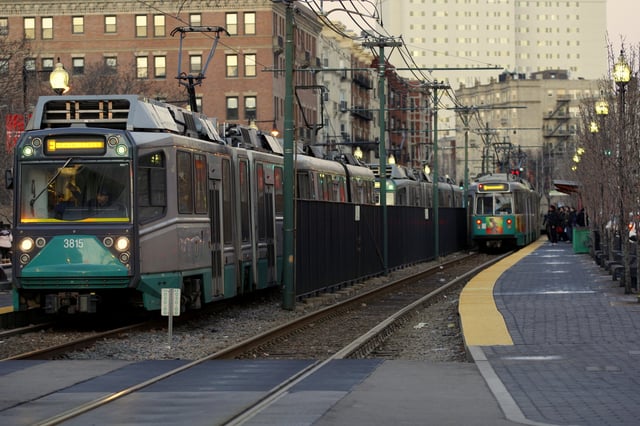
The Green Line in Boston
Each of the New England states has its own Department of Transportation which plans and develops systems for transport, though some transportation authorities operate across state and municipal lines. The Massachusetts Bay Transportation Authority (MBTA) oversees public transportation in the Greater Boston area. It is the largest such agency and operates throughout eastern Massachusetts and into Rhode Island. The MBTA oversees the oldest public subway system (the Tremont Street subway) and the second most-used line (the Green Line) in the United States. Coastal Connecticut makes use of the Metropolitan Transportation Authority of New York due to the connection of that region to New York's economy. The MTA operates the Metro-North Railroad in coordination with the Connecticut Department of Transportation. The CTDOT also operates a rail line along its southern coast terminating in Old Saybrook and New London.
Amtrak provides interstate rail service throughout New England. Boston is the northern terminus of the Northeast Corridor. The Vermonter connects Vermont to Massachusetts and Connecticut, while the Downeaster links Maine to Boston. The long-distance Lake Shore Limited train has two eastern termini after splitting in Albany, one of which is Boston. This provides rail service on the former Boston and Albany Railroad, which runs between its namesake cities. The rest of the Lake Shore Limited continues to New York City.
Bus transportation is available in most urban areas and is governed by regional and local authorities. The Pioneer Valley Transit Authority and the MetroWest Regional Transit Authority are examples of public bus transportation which support more suburban and rural communities.
South Station in Boston is the region's busiest public transportation center after Logan International Airport. The station is a major center for bus, rail, and light rail lines. Major interstate highways traversing the region include I-95, I-93, I-91, I-89, I-84, and I-90 (the Massachusetts Turnpike). Logan Airport is the busiest transportation hub in the region in terms of number of passengers and total cargo, opened in 1923 and located in East Boston and Winthrop, Massachusetts. It is a hub for Cape Air and Delta Air Lines, and a focus city for Jetblue. It is the 16th busiest airport in the United States. Other airports in the region include Burlington International Airport, Bradley International Airport, T. F. Green Airport, Manchester–Boston Regional Airport, and Portland International Jetport.
See also
Autumn in New England
Brother Jonathan
Extreme points of New England
Fieldstone
Historic New England
List of beaches in New England
List of mammals of New England
Manor of East Greenwich
New Albion
New Albion (colony)
New England/Acadian forests
New England Confederation
New England (medieval)
New England Planters
New England Summer Nationals
Northeastern coastal forests
Southeastern New England AVA wine region
Swamp Yankee
